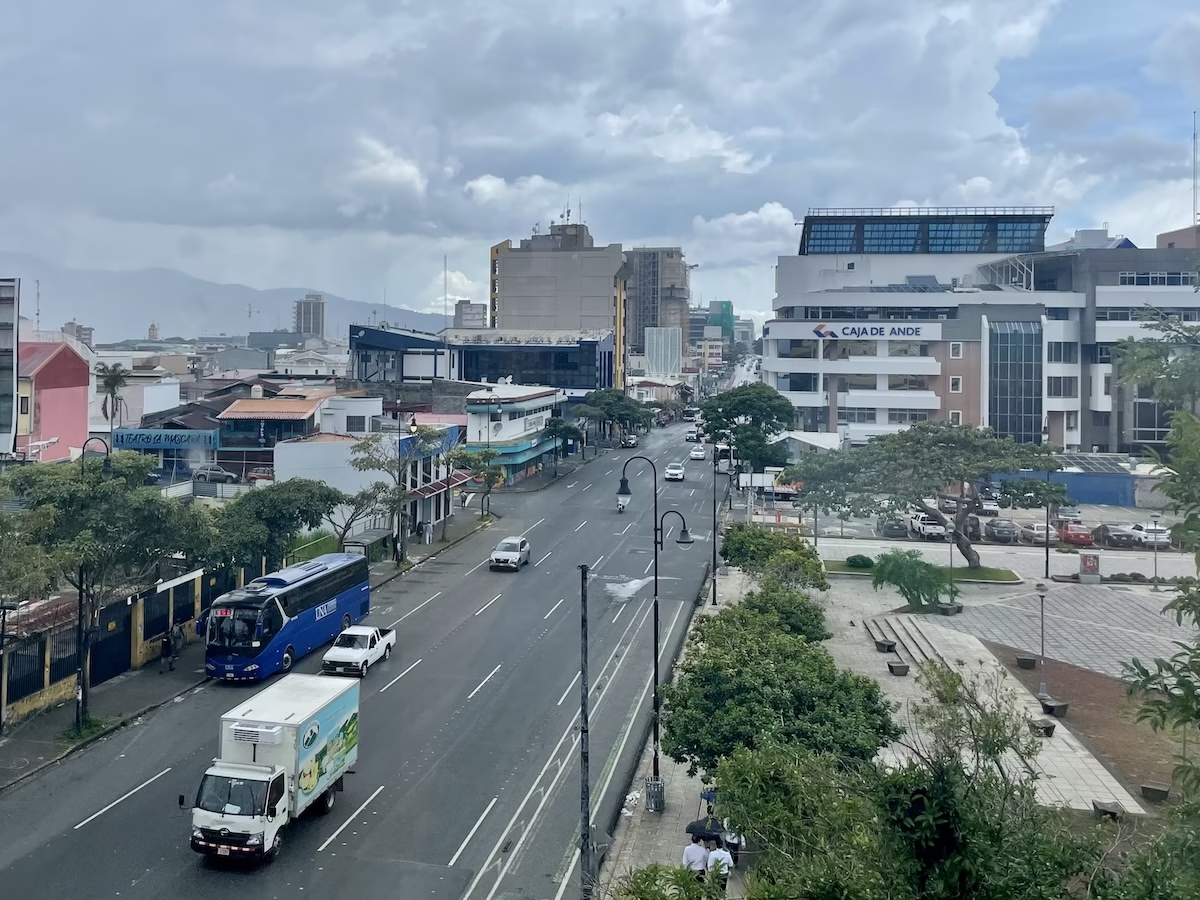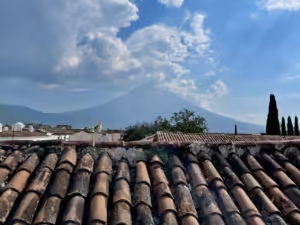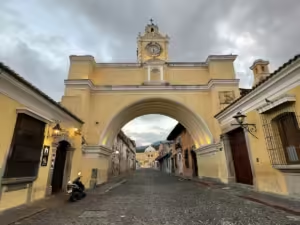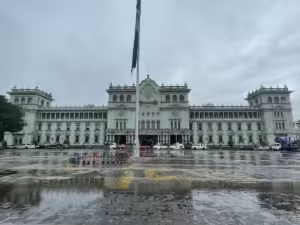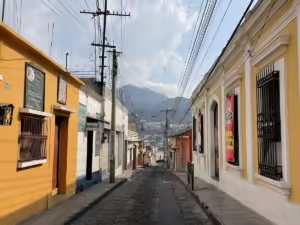San José is Costa Rica’s bustling, gritty, kind of dirty, capital city. That urban grit stands in surprising contrast to the rest of a country that’s famous for its natural environment. The only jungle you’ll find in San José is the concrete variety that Grandmaster Flash and Axel Rose once sang about. Maybe that’s why most travelers leave San José off of their Costa Rica itinerary.
I think this is a mistake. San José is Costa Rica’s modern beating heart, the center of the country’s history and culture. This is where you can go to not only learn about Costa Rica’s past, but experience its living, vibrant present. Where you begin to understand that Costa Rica is more than cloud forests and beaches, but a people and a culture. It also doesn’t hurt that San José is a pretty cool place with a hip, arty sort of vibe.
What to Know Before Visiting San José
San José is Costa Rica’s capital, largest city and economic center. It rests in the central valley, which, as the name would imply, is located in the center of the country. The metropolitan area, including nearby Alajuela, Heredia and Cartago has a population of about 2 million. It’s a big, modern city. It’s also one of the most developed and safest in Latin America.
The city was founded in 1736, but didn’t begin to take off population wise or economically until the arrival of the coffee barons in the 1800s. Unlike other Latin American cities, San José lacks a historic, colonial center. There are, however, numerous fancy buildings from the 19th century, the legacy of those coffee barons and their hubris. But, I’ll be honest, San José isn’t going to win any beauty contests.
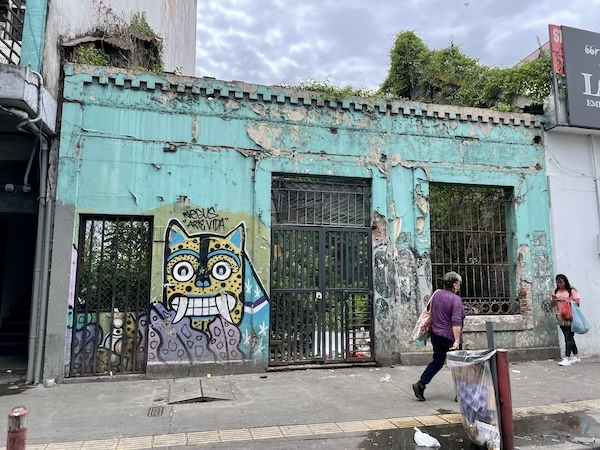
Crime and Safety
Although San José is modern and well developed, it has an enduring reputation for crime. You can read all sorts of stories online about thefts, muggings and worse. And the post-pandemic crime wave has hit the city hard, with a drastic increase in drug related crime and a spiking murder rate. All of this, as well as the ragged looking downtown neighborhoods, scare a lot of travelers away from San José.
In my experience, there’s absolutely no reason to be afraid of San José.
Yes, Costa Rica has been suffering from an increase in drug related crime. However, cartels don’t target tourists. Unless you’re trying to get involved in the drug trade, you aren’t likely to come across any of this violence. Besides, an increase in crime for Costa Rica still means less crime than neighboring Central American countries, and even a few U.S. cities.
Theft and petty crime, however, is something that can affect tourists. Nobody wants their passport stolen. Even still, the entire country of Costa Rica had 500 thefts reported by international tourists in 2024. That’s out of 2.6 million foreign visitors. I’m no mathematician, but considering those numbers, and even taking into account under-reporting, your chances of being robbed are pretty slim.
Take precautions in San José like you would in any big city anywhere. Don’t wander around alone at night. Leave your passport and valuables in your room. Don’t wave your phone around on the street like an idiot. Keep your wits about you and trust your gut. Most importantly, don’t let rumors about crime scare you away from this fascinating city.
I have some more thoughts about safety and crime in Central and South America. Read them here: Rethinking Travel Safety and Crime in Latin America
Transportation in and Around San José
All roads lead to San José. The city is Costa Rica’s major transportation hub. Even if this blog post doesn’t convince you to visit San José, you’re going to have a hard time avoiding it. The country’s main airport is here, as are bus terminals that head to everywhere from Arenal to Monteverde and pretty much every destination beyond.
Unfortunately, the bus network in Costa Rica is a little bit chaotic and not very user friendly. San José has a bunch of different bus terminals, each leading to different destinations. I’ve found Centrocoasting to be quite helpful in navigating the maze of bus terminals and bus transportation throughout Costa Rica. However, schedules change regularly, so you should be sure to inquire locally before dragging all your luggage to the bus station.
San José’s downtown is fairly walkable, but the rest of the city feels sprawled out. There are local buses, but they can be a bit confusing. Thankfully, you can find a plentiful multitude of reasonably priced taxis whenever you may need one. Taxi drivers are also great resources for recommendations, and great people to practice your Spanish with.
Uber does exist in Costa Rica, but it’s illegal. Some people will tell you to use it anyway, but I don’t recommend it. I didn’t know Uber was illegal, and got a stern talking to from a taxi driver outside the bus station. It was awkward and unpleasant and I wouldn’t wish that experience on anyone else. Just use certified, official taxis. They’ll be the red ones with the yellow triangles on the side.
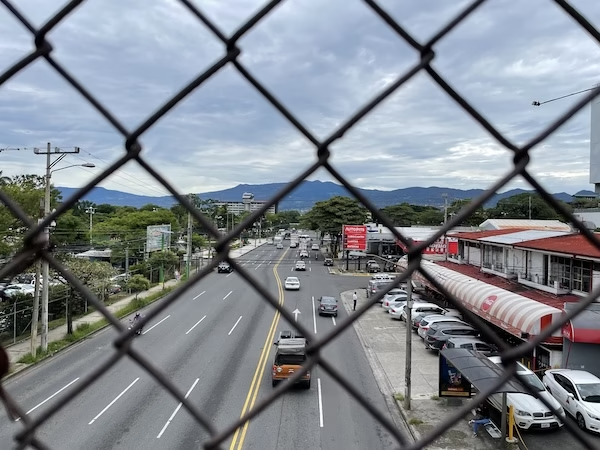
Where to Stay in San José
San José has a number of hotels, hostels, apartment rentals and whatever else you might want. These accommodations range from sleazy backpacker party hostels to fancy airport business hotels. I personally recommend the following two places, and not just because I get a small commission if you book using the following links. (At no extra cost to you, of course)
Casa Lima B&B is a lovely, friendly, little family sort of place with a cute courtyard and included breakfast. It’s in a quiet, residential neighborhood, which is nice, but the only downside is that you’re a bit far from the city center. Still, I enjoyed my stay here.
Nativus Art-Hostel is a bit more pretentious and geared to a slightly younger, hipper crowd. However, it’s centrally located and had comfortable, private rooms for a decent price.
On one of the most fun, but also most stressful, aspects of travel is finding and booking places to stay. These days you have options ranging from dirt cheap hostel dorms to luxurious White Lotus style resorts. Thankfully, the internet is here to make finding accommodation easier.
Hostelworld is the go to app for finding hostels. For everything else, there’s Booking.com. If you book through either of the previous links, I’ll gain a small commission at no extra cost to you.
What to do in San José
You’ll probably not want to spend too much time in your hotel room, because San José has a ton of cool things to do and see. I don’t think anybody could call San José a pretty city, but the concrete blocks and windy neighborhoods with tin roofs have a certain charm. You’ll find walls covered in graffiti and young Ticos wearing heavy metal band shirts in addition to some of Central America’s beset museums. The city center is walkable, and all the suggestions below are in walking distance from one another. That is, if you don’t mind walking a lot.
Museum of Jade and Pre-Colombian Art
If you only visit one museum in Costa Rica, make it this one. The building itself looks rather imposing, like it’s the fortress of some cartoon super villain. Inside, however, you’ll find mesmerizing displays about Costa Rica’s indigenous population, including a massive collection of pottery and other artifacts. As you might have guessed, the museum also has a lot of jade.
The museum is laid out according to different themes, ranging from day-to-day activities to exploring the underworld and native spirituality. It’s all very modern, but done in a really cool way that’s both entertaining and educational. It’s edutaining.
The museum is located just off of Avenida Central downtown. You can check out the official website for updated information on hours and prices. https://museodeljade.grupoins.com/informacion/
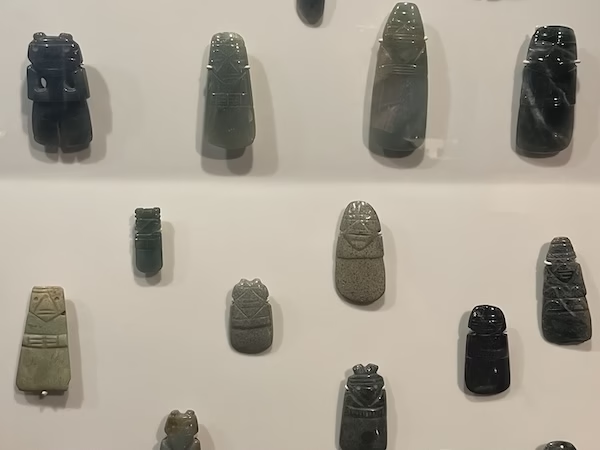
National Museum of Costa Rica
The Costa Rican national museum is the place to go to get an overview of Costa Rica’s surprisingly fascinating history. The museum is in an old army barracks. A lot of it is dedicated not only to information and displays about the 1948 civil war but also about the subsequent abolishment of the military. There’s also a decent collection of pre-Colombian artifacts, including some of those enigmatic stone spheres. Plus, it’s kind of cool to walk around an old fort.
You can find a bit more information on the official website. https://www.museocostarica.go.cr/?lang=en_en
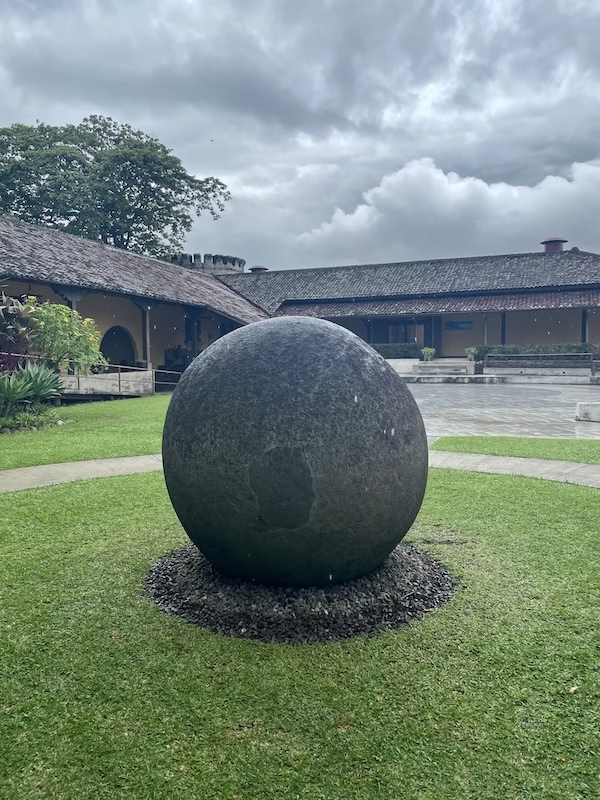
Plaza de Democracia
The Plaza de Democracia is nestled between the Jade Museum and the National Museum. It’s a nice plaza that sort of functions like the Parque Central of the city. It’s where the Ticos come to protest and demonstrate their grievances against the government and society. When we were there, we saw the graffiti remnants of a recent feminist protest. Some of the graffiti demanded legal abortion, while some demanded men learn to find the clitoris.
Nearby you can find some more permanent graffiti. The surrounding streets form a sort of open-air gallery, filled with colorful, but fading, murals and street art. It’s maybe the best street art this side of Bogota.
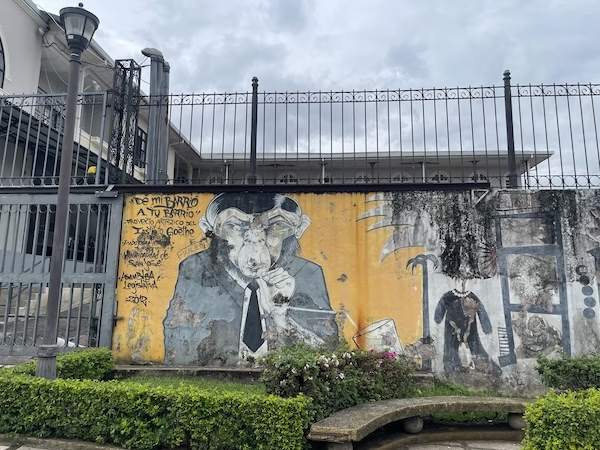
Avenida Central
Avenida Central is the main pedestrian thoroughfare of the city, cutting through the heart of downtown. The street is a monument to modern commerce, and it’s where the Ticos come to do there shopping. It’s also a great place to come and people watch, and fun to see Costa Ricans going about their daily business. You’ll also find a handful of old 19th century relics, as well as plenty of cheap clothing and a few restaurants.
The avenue runs West to East, from Paseo Colon near the hospital to the Plaza de Democracia and the National Museum.
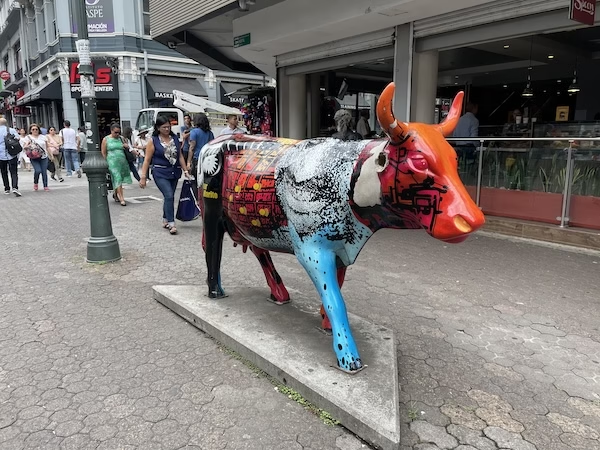
Barrio Chino
South of Avenida Central and the big museums you’ll find Costa Rica’s Barrio Chino, or China town. It isn’t nearly as impressive as New York or San Francisco, but it’s still kind of cool to see a little slice of China right in the middle of Central America. There are a handful of Asian restaurants and shops selling the kind of cheap trinkets you might be able to find in bulk on Temu.
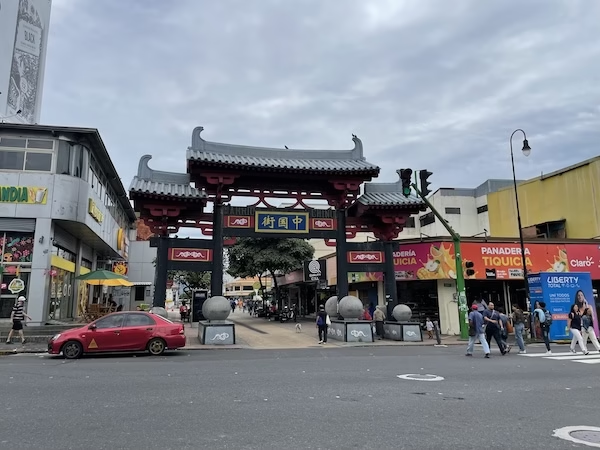
Mercado Central
One of the best parts of traveling through Central America is visiting the huge municipal markets, where you can buy everything from fresh produce to flip-flops. Unfortunately, big supermarket chains owned by Walmart have replaced most of Costa Rica’s municipal markets over the years.
Thankfully, the market survives in San José’s Mercado Central. It’s not the biggest or best market in the region, but it’s been around since the 1800s and it’s still fun to wander around through the maze of vendors. Souvenirs are also a little bit cheaper here. Just keep an eye out for pickpockets.
The Mercado Central is located just north of Avenida Central, between Calle 6 and 8.
Parque la Sabana
You might feel like San José’s asphalt jungle is severely lacking in green space. Or maybe they just piled it all into the enormous, sprawling, Parque Metropolitano La Sabana. This massive park just outside of downtown has numerous trails, an outdoor sculpture garden and a little pond that’s trying its best. You’ll find local Tico families jogging, playing or having a picnic in the grass. There’s also an art museum and some other things to see, but they all seemed closed when we were there.
You can find Parque la Sabana just west of downtown at the far end of Paseo Colon. Just look for the big green blob on your phone’s map.
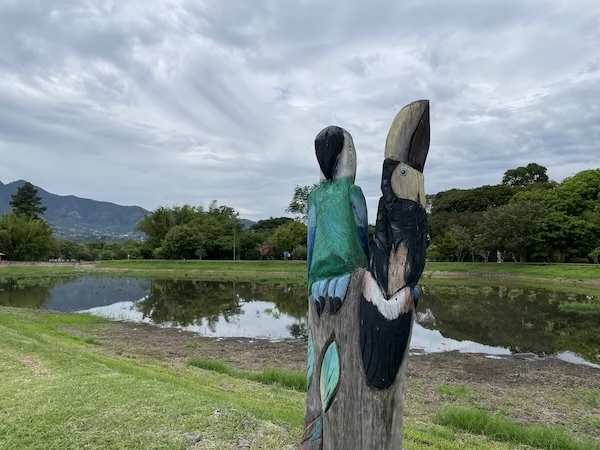
Some of us like to fly by the seat of our pants and not plan anything. Others crawl by the hem of our pants and meticulously plan every detail. If you’re a planner, I suggest using Get Your Guide to book tours. They’re generally cheaper than online alternatives and offer a wide range of activities. If you book through the following link, I’ll get a small commission at no cost to you and you’ll gain the satisfaction of supporting an independent travel blog. Click here to explore tours in Costa Rica.
Final Thoughts on San José
I’ve been to San José at least five times now, sometimes just passing through, other times spending three or four nights here. Every time I come, I feel like I discover something new. And I still haven’t really explored beyond downtown.
A lot of people will tell you to skip San José, or at best just to use it as a transportation hub. I think this is a huge mistake. Because most travelers skip it, there’s also something that feels off-the-beaten path or undiscovered about San José. It’s like an urban secret you keep to yourself, and, uh, like 2 million other people.
Costa Rica is burdened with an overwhelming amount of natural beauty, but its cultural heart is San José. The city pulses with a lively, artistic, sometimes grimy energy that’s surprisingly infectious. I like it.
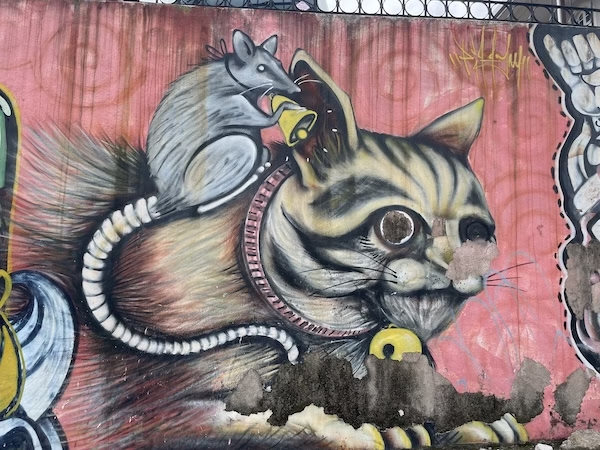
Excited to discover more about Costa Rica? Check out our guide, here: Come to Costa Rica: A Travel Guide to the Tourist Hotspot I Still Love
Useful Websites for Traveling Costa Rica
As much as we might long for the days when you could show up to a town with nothing more than a beat-up guidebook and a sense of adventure, today much of traveling involves being glued to our phones making bookings. I’ve compiled some helpful apps and websites below that at least help make those bookings more convenient so you can spend less time staring at your phone and more time exploring at your surroundings. Some of these sites are affiliate links that give me a small commission at no cost to you if you chose to book through them. All of them are sites I’ve used personally and have no problem recommending.
Just be sure to do your due diligence as much as possible. Only hire local guides and try as much as possible to stay in locally owned hotels and hostels so that your hard earned travel dollars actually go to support the local economies of the places you visit.
Booking.com is basically the world’s only hotel booking website. They have hotels, guesthouses and vacation rentals all over Costa Rica.
Hostelworld is the go-to site for booking hostels. If dorm rooms and shared bathrooms are your thing, you’ll find hostels all over Costa Rica.
Get Your Guide offers tours and activities all around the world. Unlike some other sites and apps that do the same thing, you can actually find some reasonably priced deals here.
Centro Coasting is a great website to look up bus routes and times throughout Central America. Schedules change regularly, and the site is sometimes not as up to date as you’d like. However, it’s a good resource to help give you an idea when the buses leave, or at least get you to the right terminal.

